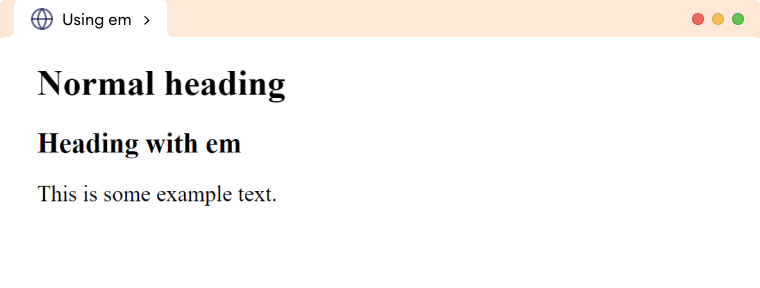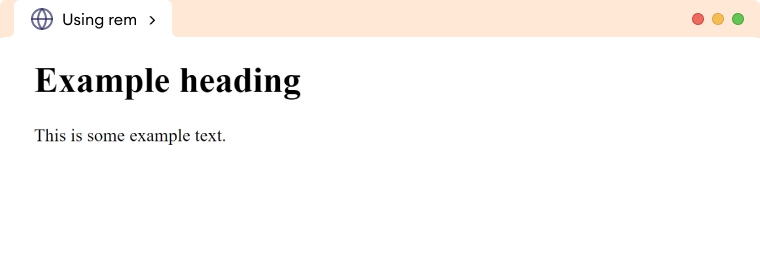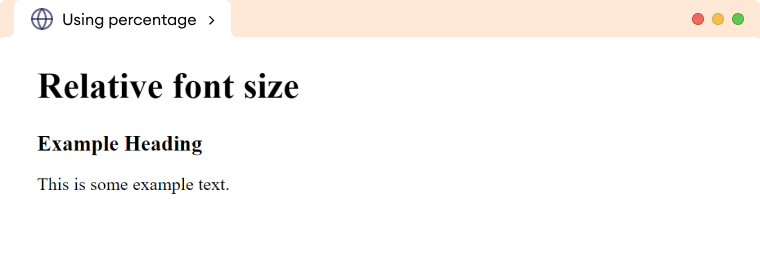CSS font-size 属性调整网页上的文本大小。例如,
p {
font-size: 36px;
}浏览器输出

这里,font-size: 36px 将 p 元素的字体大小设置为 36px。
CSS 字体大小语法
font-size 属性具有以下语法:
font-size: predefined keyword|length|initial|inherit;这里,
- 预定义关键词:指具有预定
font-size的关键词,如small、medium、large等。 - 长度:指使用特定长度单位(如
px、em或点)的font-size,例如24px、2em等。
font-size 的可能值如下:
| 值 | 描述 |
|---|---|
xx-small |
显示极小文本大小 |
x-small |
显示特小文本大小 |
small |
显示小文本大小 |
medium |
显示中等文本大小 |
large |
显示大文本大小 |
x-large |
显示特大文本大小 |
xx-large |
显示极大文本大小 |
xx-small |
显示极小文本大小 |
x-small |
显示特小文本大小 |
smaller |
显示相对较小的文本大小 |
larger |
显示相对较大的文本大小 |
initial |
将字体大小设置为默认值 |
inherit |
从父元素继承字体大小 |
绝对值和相对值
CSS 字体大小可以指定为:
- 绝对值
- 相对值
1. 使用绝对值的字体大小
绝对值将大小设置为固定的指定值。它们以特定的长度值指定,例如像素 (px)、点 (pt) 等。例如,
<!DOCTYPE html>
<html lang="en">
<head>
<meta charset="UTF-8" />
<meta name="viewport" content="width=device-width, initial-scale=1.0" />
<link rel="stylesheet" href="style.css" />
<title>Using absolute length units</title>
</head>
<body>
<p class="first_paragraph">font size of 24 points</p>
<p class="second_paragraph">font size of 16 pixels</p>
<p class="third_paragraph">font size of 10 millimeters</p>
</body>
</html>p.first_paragraph {
/* sets the font size to 24 points */
font-size: 24pt;
}
p.second_paragraph {
/* sets the font size to 16 pixels */
font-size: 16px;
}
p.third_paragraph {
/* sets the font size to 10 millimeters */
font-size: 10mm;
}浏览器输出

注意:像素 (px) 通常用作网页上字体大小的绝对单位。像素提供了一种一致而精确的方式来指定字体大小,不受用户偏好或设备分辨率的影响。
2. 使用相对值的字体大小
相对值将大小设置为相对于其父元素。
相对值使用关键词和百分比值指定。例如,
<!DOCTYPE html>
<html lang="en">
<head>
<meta charset="UTF-8" />
<meta name="viewport" content="width=device-width, initial-scale=1.0" />
<link rel="stylesheet" href="style.css" />
<title>Using em</title>
</head>
<body>
<h1>Normal heading</h1>
<div>
<h1>Heading with em</h1>
<p>This is some example text.</p>
</div>
</body>
</html>div {
font-size: 20px;
}
div h1 {
font-size: 1.25em;
}浏览器输出

在上面的示例中,我们有两个 <h1> 元素,一个在 <div> 元素之外,另一个在 <div> 元素之内。第一个 <h1> 元素具有默认大小,而第二个 <h1> 元素具有 1.25em 的 font-size,它相对于其父元素 <div> 的 font-size。
<div> 的 font-size 为 20px,因此 <div> 中 <h1> 的 font-size 将是 20px 的 1.25 倍,即 25px。
常见问题
虽然 em 基于父元素的 font-size,但 rem 基于根元素 html 中设置的 font-size。例如,
<!DOCTYPE html>
<html lang="en">
<head>
<meta charset="UTF-8" />
<meta name="viewport" content="width=device-width, initial-scale=1.0" />
<link rel="stylesheet" href="style.css" />
<title>Using rem</title>
</head>
<body>
<h1>Example heading</h1>
<p>This is some example text.</p>
</body>
</html>html {
/*set the font size to 18px,
default would be 16px */
font-size: 18px;
}
h1 {
/*sets font-size to 2 * 18px = 36px*/
font-size: 2rem;
}
p {
/* sets font-size to 18px */
font-size: 1rem;
}浏览器输出

<!DOCTYPE html>
<html lang="en">
<head>
<meta charset="UTF-8" />
<meta name="viewport" content="width=device-width, initial-scale=1.0" />
<link rel="stylesheet" href="style.css" />
<title>Using percentage</title>
</head>
<body>
<h1>Relative font size</h1>
<div>
<h1>Example Heading</h1>
<p>This is some example text.</p>
</div>
</body>
</html>/*sets div font size to 20px */
.div {
font-size: 20px;
}
/*sets h1 font size to 120% */
div h1 {
font-size: 120%;
}浏览器输出

在上面的示例中,第一个 <h1> 元素的 font-size 没有明确设置,因此它使用默认大小。
第二个 <h1> 元素的 font-size 为 120%,相对于其父元素。父元素 <div> 的 font-size 为 20px,因此第二个 <h1> 元素的字体大小将是 20px 的 120%,即 24px。